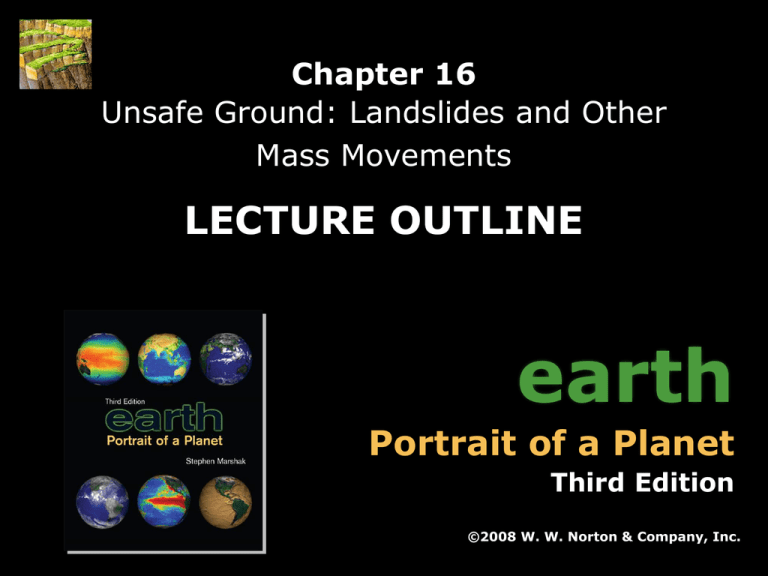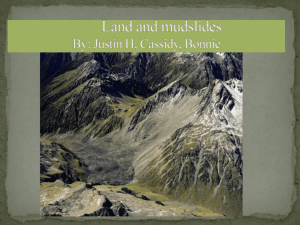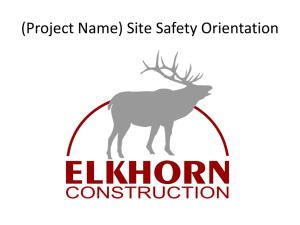Landslides and Other Mass Movements
advertisement

Chapter 16 Unsafe Ground: Landslides and Other Mass Movements LECTURE OUTLINE earth Portrait of a Planet Third Edition ©2008 W. W. Norton & Company, Inc. Earth: Portrait of a Planet, 3rd edition, by Stephen Marshak Chapter 16: Unsafe Ground: Landslides and Other Mass Movements Unsafe Ground: Landslides and Other Mass Movements Prepared by Ronald Parker Earlham College Department of Geosciences Richmond, Indiana Introduction Most humans consider Earth to be “terra firma.” Earth’s surface, however, is mostly unstable ground. This is a consequence of weathering and erosion. We may be reminded of this instability without warning. Earth: Portrait of a Planet, 3rd edition, by Stephen Marshak Chapter 16: Unsafe Ground: Landslides and Other Mass Movements Mass Movement Downslope motion of Earth materials by gravity. Mass movements are a type of natural hazard. Natural feature of the environment. Can cause damage to living things and buildings. These hazards can produce catastrophic losses. Earth: Portrait of a Planet, 3rd edition, by Stephen Marshak Chapter 16: Unsafe Ground: Landslides and Other Mass Movements Mass Movements Mass movements are important to the rock cycle. The initial step in sediment transportation. A significant agent of landscape change. All slopes are unstable; they change continuously. Mass movement is often aided by human activity. Earth: Portrait of a Planet, 3rd edition, by Stephen Marshak Chapter 16: Unsafe Ground: Landslides and Other Mass Movements Types of Mass Wasting Classified based on 4 factors. Type of material (rock, regolith, snow, or ice). Rate of movement (fast, intermediate, or slow). Nature of moving mass (cloud, slurry, or distinct blocks). Surroundings (subaerial or submarine). Earth: Portrait of a Planet, 3rd edition, by Stephen Marshak Chapter 16: Unsafe Ground: Landslides and Other Mass Movements Types of Mass Wasting Earth: Portrait of a Planet, 3rd edition, by Stephen Marshak Chapter 16: Unsafe Ground: Landslides and Other Mass Movements Types of Mass Wasting Creep – Slow downhill movement of regolith. Due to expansion and contraction. Wetting and drying. Freezing and thawing. Grains are moved… Perpendicular to slope upon expansion. Vertically by gravity upon contraction. Earth: Portrait of a Planet, 3rd edition, by Stephen Marshak Chapter 16: Unsafe Ground: Landslides and Other Mass Movements Types of Mass Wasting Creep initiates tilt of trees, gravestones, and walls. Earth: Portrait of a Planet, 3rd edition, by Stephen Marshak Chapter 16: Unsafe Ground: Landslides and Other Mass Movements Types of Mass Wasting Solifluction – Slow downhill movement of tundra. Melted permafrost slowly flows over deep-frozen soil. This process generates hillsides with solifluction lobes. Rock glaciers – Mixtures of rock fragments and ice. Rocks are added faster than ice can accumulate. These behave like glacial ice, flowing downhill slowly. Earth: Portrait of a Planet, 3rd edition, by Stephen Marshak Chapter 16: Unsafe Ground: Landslides and Other Mass Movements Types of Mass Wasting Slumping - Sliding of regolith as coherent blocks. Slippage occurs along a spoon-shaped “failure surface.” Variety of sizes and rates of motion. Distinctive… Head scarp. Bulging toe. Earth: Portrait of a Planet, 3rd edition, by Stephen Marshak Chapter 16: Unsafe Ground: Landslides and Other Mass Movements Types of Mass Wasting Mudflows and debris flows – H2O-rich movement. Mudflow – A slurry of water and fine sediment. Debris flow – A mudflow with many large rocks. Earth: Portrait of a Planet, 3rd edition, by Stephen Marshak Chapter 16: Unsafe Ground: Landslides and Other Mass Movements Types of Mass Wasting Lahar – A special volcanic mud or debris flow. Volcanic ash from recent or ongoing eruptions. Water from heavy rains or melted glacial ice. Earth: Portrait of a Planet, 3rd edition, by Stephen Marshak Chapter 16: Unsafe Ground: Landslides and Other Mass Movements Lahar Case History Nevada del Ruiz volcano in the Colombian Andes. The volcano erupted the night of 11/13/85. Eruption melted some of the mountain’s snowcap. Melt water mixed with ash and raced down river valleys. Armero was buried, killing 20,000 residents in their sleep. Earth: Portrait of a Planet, 3rd edition, by Stephen Marshak Chapter 16: Unsafe Ground: Landslides and Other Mass Movements Types of Mass Wasting Landslides – Movement down a nonvertical slope. Rock slide – Slide consisting of rock only. Debris slide – Slide mostly made of regolith. Movement down failure surface is sudden and deadly. Slide debris can move 300 km/hr on a cushion of air. Earth: Portrait of a Planet, 3rd edition, by Stephen Marshak Chapter 16: Unsafe Ground: Landslides and Other Mass Movements Landslide Case Study The Vaiont Dam disaster – Illustrates the need to evaluate geology when siting critical structures. Built in 1960 in a deep synclinal gorge in the Italian Alps. Limestone over shale dipped toward the valley center. On 10/9/63, 600 million tons of limestone fell into the reservoir. A wave crested the dam, destroyed villages, and killed 2,600. Earth: Portrait of a Planet, 3rd edition, by Stephen Marshak Chapter 16: Unsafe Ground: Landslides and Other Mass Movements Types of Mass Wasting Avalanches – Turbulent clouds of debris and air. Snow avalanche – Oversteepened snow that detaches. Debris avalanche – Rock and dust fragments. Move up to 250 km/hr on a cushioning layer of air. Reoccur in defined chutes; destroy stationary objects. Earth: Portrait of a Planet, 3rd edition, by Stephen Marshak Chapter 16: Unsafe Ground: Landslides and Other Mass Movements Types of Mass Wasting Rockfalls and debris falls – Vertical freefall. Bedrock or regolith that falls rapidly down. When blocks impact, they fragment and continue moving. Talus blocks pile up at the base of the slope. Earth: Portrait of a Planet, 3rd edition, by Stephen Marshak Chapter 16: Unsafe Ground: Landslides and Other Mass Movements Types of Mass Wasting Submarine mass movements. 3 types – Based on degree of disintegration. Submarine slumps – Coherent blocks break and slip. Submarine debris flows – Moving material breaks apart. Turbidity currents – Sediment moves as a turbulent cloud. Usually well-preserved. Earth: Portrait of a Planet, 3rd edition, by Stephen Marshak Chapter 16: Unsafe Ground: Landslides and Other Mass Movements Types of Mass Wasting Submarine mass movements. Gigantic submarine slope failures are widespread. Much larger than land-based slope failures. Important process sculpting adjacent land. Create catastrophic tsunamis. Earth: Portrait of a Planet, 3rd edition, by Stephen Marshak Chapter 16: Unsafe Ground: Landslides and Other Mass Movements Weakening the Surface Mass movements require that Earth materials... Be subjected to topographic (slope) forces. Be weakened or loosened from their attachments. Fragmentation and weathering. The upper crust is broken by jointing and faulting. Chemical and physical weathering produces regolith. Surface material is much weaker that solid crustal rock. Earth: Portrait of a Planet, 3rd edition, by Stephen Marshak Chapter 16: Unsafe Ground: Landslides and Other Mass Movements Weakening the Surface Slopes may be stable or unstable. Slope stability is a trade-off between two forces. Downslope force – Gravitational pull. Resisting force – Material properties that repel motion. Movement occurs when downslope forces prevail. Earth: Portrait of a Planet, 3rd edition, by Stephen Marshak Chapter 16: Unsafe Ground: Landslides and Other Mass Movements Slope Stability Downslope forces = Gravity. The weight of Earth materials. The weight of added water. The weight of added structures. Resisting forces = Material strength. Cohesion. Chemical bonds. Electrical charges. Surface tension. Friction. Steeper slopes = larger forces. Earth: Portrait of a Planet, 3rd edition, by Stephen Marshak Chapter 16: Unsafe Ground: Landslides and Other Mass Movements Slope Stability Loose granular material assumes a slope angle. “Angle of repose” is a material property due to... Particle size, shape, and surface roughness. Typical angles of repose. Fine sand Coarse sand Angular pebbles Earth: Portrait of a Planet, 3rd edition, by Stephen Marshak 35o 40o 45o Chapter 16: Unsafe Ground: Landslides and Other Mass Movements Failure Surfaces Weak subsurface layers can initiate motion. Types of “failure surfaces” include… Saturated sand or clay layers. Joints parallel to the surface. Weak sedimentary bedding (shale, evaporites). Metamorphic foliation. Earth: Portrait of a Planet, 3rd edition, by Stephen Marshak Chapter 16: Unsafe Ground: Landslides and Other Mass Movements Failure Triggers A destabilizing event usually triggers slope failure. Triggers are both natural and anthropogenic. Shocks and vibrations. Changes in slope characteristics. Changes in slope strength. Earth: Portrait of a Planet, 3rd edition, by Stephen Marshak Chapter 16: Unsafe Ground: Landslides and Other Mass Movements Failure Triggers A triggering event is not necessary for movement. Slope materials weaken over time. Gravity continues to operate. Mass movements are often random and unpredictable. Earth: Portrait of a Planet, 3rd edition, by Stephen Marshak Chapter 16: Unsafe Ground: Landslides and Other Mass Movements Failure Triggers Shocks and vibrations. Ground vibrations decrease material friction. On an unstable slope, the downslope force takes over. Many sources of vibration are common. Motion of heavy machinery, vehicles, or trains. Earthquakes. Earth: Portrait of a Planet, 3rd edition, by Stephen Marshak Chapter 16: Unsafe Ground: Landslides and Other Mass Movements Failure Triggers Vibrations cause saturated sediments to liquefy. Quick clay – Pore water slurries clay flakes when shaken. Saturated sand – Fluidized by increase in pore pressure. Earth: Portrait of a Planet, 3rd edition, by Stephen Marshak Chapter 16: Unsafe Ground: Landslides and Other Mass Movements Failure Triggers Changes in characteristics can destabilize a slope. Angle – Steepening a slope beyond the angle of repose. Loading – Adding weight to the top of a slope. Water – As rain or via humans (lawns, septic systems). Waste materials and fill. Buildings. Earth: Portrait of a Planet, 3rd edition, by Stephen Marshak Chapter 16: Unsafe Ground: Landslides and Other Mass Movements Failure Triggers Changes in characteristics can destabilize a slope. Removing support – Undercutting a slope leads to failure. Natural – River eroding base of slope. Human-induced – Excavating the base of a slope. Earth: Portrait of a Planet, 3rd edition, by Stephen Marshak Chapter 16: Unsafe Ground: Landslides and Other Mass Movements Failure Triggers Changes in slope strength. Weathering – Creates weaker regolith. Vegetation – Stabilizes slopes. Removing it… Greatly slows removal of excess water. Destroys an effective stapling mechanism (roots). Failures common after forest fires. Earth: Portrait of a Planet, 3rd edition, by Stephen Marshak Chapter 16: Unsafe Ground: Landslides and Other Mass Movements Failure Triggers Changes in slope strength. Water – Reduces slope strength in several ways. Adds a great deal of weight. Water in pores pushes grains apart, easing disintegration. Water lubricates grain contacts. Earth: Portrait of a Planet, 3rd edition, by Stephen Marshak Chapter 16: Unsafe Ground: Landslides and Other Mass Movements Case Study 1925 Gros Ventre slide, near Jackson Hole, Wy. Gros Ventre River cut dipping beds on Sheep Mtn. Lubricated by rain, the slope slid down a shale unit. 40 million m3 slid 600 m, creating Slumgullion Lake. Earth: Portrait of a Planet, 3rd edition, by Stephen Marshak Chapter 16: Unsafe Ground: Landslides and Other Mass Movements Tectonic Linkage Tectonic processes influence mass movements. Create uplift – Topography is directly linked to gravity. Fragment crust – Joints and faults ease disintegration. Generate seismicity – Earthquakes trigger motion. Earth: Portrait of a Planet, 3rd edition, by Stephen Marshak Chapter 16: Unsafe Ground: Landslides and Other Mass Movements Identifying Slope Hazards Geologic mapping can identify regions at risk. Can identify past failures (scarps, hummocky land, etc.) Can identify currently unstable slopes. Cracked and bulging ground. Measurable changes in surveyed land features. GPS can detect slow movements. Earth: Portrait of a Planet, 3rd edition, by Stephen Marshak Chapter 16: Unsafe Ground: Landslides and Other Mass Movements Mitigating Slope Hazards How can humans mitigate the slope hazards? Develop strategies for minimizing disaster potential. Institutional controls on development. Well-designed evacuation plans. Slope-monitoring programs. An educated populace. Earth: Portrait of a Planet, 3rd edition, by Stephen Marshak Chapter 16: Unsafe Ground: Landslides and Other Mass Movements Prevention Action can reduce mass-movement hazards. Revegetation – Adding plants has two positive effects. It removes water by evapotranspiration. Roots help to bind and anchor regolith. Earth: Portrait of a Planet, 3rd edition, by Stephen Marshak Chapter 16: Unsafe Ground: Landslides and Other Mass Movements Prevention Action can reduce mass-movement hazards. Regrading – Reshaping slopes below the angle of repose. Drainage – Dewatering reduces weight, increases strength. Earth: Portrait of a Planet, 3rd edition, by Stephen Marshak Chapter 16: Unsafe Ground: Landslides and Other Mass Movements Prevention Action can reduce mass-movement hazards. Slowing or eliminating undercutting – Increases stability. Removing agent of erosion at the base of a slope. Reducing the effect of the agent of erosion (i.e., riprap). Earth: Portrait of a Planet, 3rd edition, by Stephen Marshak Chapter 16: Unsafe Ground: Landslides and Other Mass Movements Prevention Action can reduce mass-movement hazards. Engineered structures – Safety structures can be built to improve slope stability or to reduce movement hazards. Retaining walls – Barriers that pin the base and trap rock. Covers – A fence or coating that drapes over the outcrop. Earth: Portrait of a Planet, 3rd edition, by Stephen Marshak Chapter 16: Unsafe Ground: Landslides and Other Mass Movements Prevention Engineered structures. Rock staples – Rods drilled into rock to hold loose facing. Earth: Portrait of a Planet, 3rd edition, by Stephen Marshak Chapter 16: Unsafe Ground: Landslides and Other Mass Movements Prevention Engineered structures. Avalanche sheds – Structures that shunt avalanche snow. Controlled blasting – Surgical removal of dangerous rock. Earth: Portrait of a Planet, 3rd edition, by Stephen Marshak Chapter 16: Unsafe Ground: Landslides and Other Mass Movements This concludes the Chapter 16 Unsafe Ground: Landslides and Other Mass Movements LECTURE OUTLINE earth Portrait of a Planet Third Edition ©2008 W. W. Norton & Company, Inc. Earth: Portrait of a Planet, 3rd edition, by Stephen Marshak Chapter 16: Unsafe Ground: Landslides and Other Mass Movements








